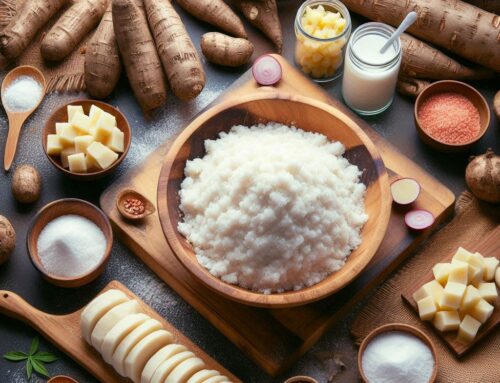
Introduction: Understanding the Basics of Cassava Propagation
Cassava propagation is a fascinating and essential process for anyone interested in root crop cultivation. This resilient plant, known for its adaptability and high yield, is a staple in many tropical regions. Understanding the basics of cassava propagation can greatly enhance your gardening efforts, whether you’re a seasoned farmer or an enthusiastic home gardener.
The cassava plant is typically propagated through stem cuttings rather than seeds. This method ensures that the new plants retain the desirable traits of their parent plant, such as disease resistance and high productivity. To begin with cassava propagation, select healthy stems from mature plants that are about 8 to 12 months old. Cut these stems into sections approximately 20-30 centimeters long, ensuring each piece has several nodes where new roots will develop.
Planting these cuttings involves placing them horizontally or at an angle in well-drained soil with good sunlight exposure. It’s important to maintain consistent moisture levels during the initial stages of growth to encourage root development. With these gardening tips in mind, you can successfully grow cassava and enjoy its numerous benefits as a versatile food source.
By mastering the art of cassava propagation, you’ll not only contribute to sustainable agriculture but also gain insight into one of the world’s most important crops. Whether you’re cultivating it for personal consumption or commercial purposes, understanding these basic principles will set you on a path towards successful root crop cultivation.
Selecting the Right Cassava Variety for Your Garden
When it comes to selecting the right cassava variety for your garden, understanding the different options available can make all the difference in achieving a successful harvest. Cassava, known for its versatility and resilience, offers various varieties that cater to specific growing conditions and desired outcomes.
To choose the best cassava for your home garden, consider factors such as climate compatibility, soil type, and intended use. Some cassava varieties are bred specifically for high yield and disease resistance, making them ideal choices for gardeners looking to maximize their production. Varieties like “TME 419” and “TMS 30572” are renowned for their robust yields and adaptability across diverse environments.
Additionally, think about the culinary qualities you desire. Certain types of cassava have a higher starch content or distinct flavors that may suit particular recipes better than others. By researching these characteristics in advance, you can ensure that your chosen variety aligns with both your gardening goals and culinary preferences.
Ultimately, selecting the right cassava variety involves balancing agronomic performance with personal taste considerations. With careful planning and informed decision-making, you can enjoy a bountiful harvest of this staple crop from your own backyard.
Preparing Your Garden for Planting Cassava Cuttings
Before planting cassava cuttings, it’s essential to ensure that your garden is well-prepared to support healthy growth. Garden preparation begins with selecting the right site, which should receive ample sunlight and have good drainage to prevent waterlogging—a critical factor since cassava thrives in well-drained soils.
Understanding the soil requirements for cassava is key to successful cultivation. Cassava prefers sandy loam or loamy soil types rich in organic matter, which facilitates root development and nutrient absorption. Conduct a soil test to determine pH levels; ideally, the pH should range between 5.5 and 7.0 for optimal growth.
Once you’ve identified a suitable planting site, begin by clearing it of weeds and debris that could compete with your cassava plants for nutrients and space. Next, till the soil to a depth of at least 30 centimeters (about 12 inches) to loosen it up, improving aeration and root penetration.
Incorporating organic compost or well-rotted manure into the soil will enhance its fertility, providing essential nutrients that support vigorous plant growth. Ensure that any amendments are evenly distributed throughout the planting area.
By meticulously preparing your garden with these steps in mind—focusing on site selection, understanding cassava’s specific soil needs, and enhancing soil quality—you’ll set a strong foundation for thriving cassava plants ready to yield a bountiful harvest.
The Step-by-Step Process of Propagating Cassava from Cuttings
Propagating cassava from cuttings is a straightforward and efficient method to ensure a bountiful harvest. This process begins with selecting healthy and mature cassava stems, typically around 8 to 12 months old. These stems should be free of disease and pests, as the health of the cutting directly impacts the growth of your new plants.
Start by cutting the stem into sections approximately 20 to 30 centimeters long, ensuring each section has at least three to five nodes. These nodes are crucial as they are the points from which roots and shoots will develop. Once your cuttings are prepared, it’s time for planting.
For optimal growth, plant your cassava cuttings in well-drained soil with good fertility. Insert each cutting vertically into the soil with about two-thirds of its length buried underground. Make sure that at least one or two nodes remain above ground level to allow for shoot development.
Watering is essential during the early stages after planting cassava cuttings. Ensure that the soil remains moist but not waterlogged, as excessive moisture can lead to rot. As your plants grow, gradually reduce watering frequency while maintaining consistent moisture levels in dry periods.
By following these steps on how to grow cassavas from cuttings, you can effectively propagate this versatile crop using simple propagation methods for cassavas that maximize yield and ensure healthy plant development throughout their growing cycle.
Essential Care Tips to Ensure Healthy Growth and High Yield
Cassava is a resilient and versatile crop, but to ensure healthy growth and high yield, it requires attentive care. One of the fundamental cassava care tips is proper watering. Cassavas thrive in well-drained soil and require consistent moisture, particularly during the initial growth stages. Watering instructions for cassavas suggest providing sufficient water once or twice a week, depending on rainfall and soil conditions, to keep the soil evenly moist but not waterlogged.
Fertilizing your plants naturally is another crucial aspect of nurturing cassava. Organic fertilizers such as compost or well-rotted manure can enrich the soil with essential nutrients without the risk of chemical build-up. Incorporating these natural fertilizers into the soil before planting and periodically throughout the growing season can significantly boost plant health and productivity.
Pest control in gardens is vital for protecting cassava from common threats like aphids and mites. Employing natural pest control methods, such as introducing beneficial insects like ladybugs or using neem oil sprays, can effectively manage pests while preserving ecological balance. Regular monitoring of plants for signs of infestation will allow for timely intervention, ensuring your cassava remains healthy throughout its growth cycle. By following these essential care tips, gardeners can look forward to a bountiful harvest of this valuable crop.
Troubleshooting Common Issues in Cassava Cultivation and How to Overcome Them
Cassava cultivation, while rewarding, can present several challenges that require careful attention and management. One of the primary concerns is disease management in root crops. Cassava is susceptible to a range of diseases such as cassava mosaic disease and bacterial blight, which can significantly impact yield. To combat these, it’s essential to implement integrated pest management strategies that include regular monitoring and the use of resistant varieties.
Common problems with growing roots also include inadequate soil fertility and poor drainage. Cassava thrives in well-drained soils with adequate nutrients. To address soil-related issues, farmers should conduct soil tests to determine nutrient levels and amend the soil accordingly with organic matter or fertilizers.
Identifying signs of unhealthy plants early on can prevent more significant losses. Look for symptoms such as wilting leaves, stunted growth, or discolored foliage, which may indicate underlying issues like nutrient deficiencies or pest infestations. Regular inspections and prompt action are crucial in maintaining healthy cassava plants.
By understanding these common challenges and implementing effective solutions, farmers can enhance their cassava production and ensure a successful harvest season after season.
Conclusion : Enjoy Bountiful Harvests by Mastering Cassava Propagation Techniques
In conclusion, mastering cassava propagation techniques is essential for achieving bountiful harvests and ensuring the sustainability of this vital crop. By understanding the nuances of stem cutting selection, proper planting methods, and optimal growing conditions, farmers can significantly enhance their yields. It’s important to choose healthy, disease-free cuttings and plant them at the correct depth and spacing to promote robust growth.
Additionally, maintaining soil fertility through regular organic matter incorporation and monitoring for pests can further support healthy cassava development. Farmers should also consider experimenting with improved varieties that are suited to their specific climatic conditions to maximize productivity.
By investing time in mastering these propagation techniques, farmers not only ensure a steady supply of cassava but also contribute to food security in their communities. With dedication and informed practices, anyone can enjoy the rewards of a plentiful cassava harvest year after year.






